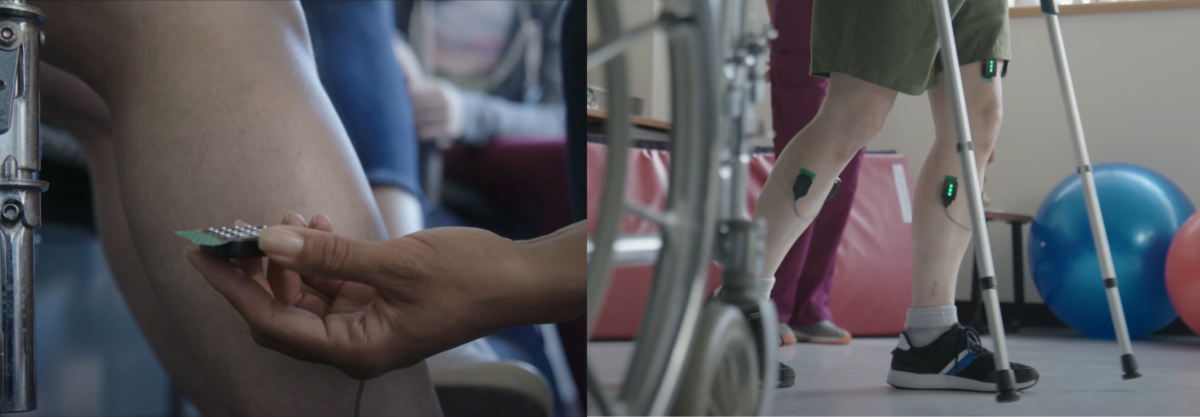What is sEMG?
The human body is a complicated network of neural pathways. For any movement, and for us to be able to interact with the world around us, the messages from the brain need to be successfully delivered to the muscles. Detecting and deciphering how the brain controls movement has continued to develop over the past years. A common way to assess human movement, and the contribution of different muscles towards force generation, is to use surface electromyography (sEMG or EMG). EMG is an experimental technique that involves the recording and analysis of the myoelectric signals formed by the physiological variations in the state of the muscle fibre membranes. By gaining insight into the status of muscular excitation, researchers, clinicians, sports practitioners, and engineers have been able to determine:
- The level of muscular effort involved – gained from assessing the overall EMG signal amplitude.
- Co-ordination between muscles – assessed by the activation timings of muscles.
- The effects of muscle fatigue – an exploration of the frequency component of the EMG signal.
- Neural control strategies – how is the brain adapting to training or external stimuli.

However, over the past decade there has been a rise in the popularity of using high-density surface electromyography (HDsEMG). In many applications, muscle activation may be treated as relatively homogenous across the whole region of the muscle. However, as we continue to evolve methodologies and technologies within electrophysiology, more evidence has come to light that muscles are heterogenous in their activation strategies between different regions of the muscle. This blog will look to provide further information on the background, applications, and current uses of HDsEMG within an array of scenarios.
The origins and outputs of HDsEMG
HDsEMG has been defined as the use of four or more closely spaced electrodes to give insights into the spatial distribution of myoelectric excitation across a muscle. While traditional EMG gives an insight into the global activation strategies of the muscles, HDsEMG offers a window into the regional excitation and hence the recruitment and modulation of localized motor units within or between muscles.
HDsEMG techniques have allowed for new questions to be asked within neurophysiology, neurorehabilitation, engineering, sports science, ergonomics, and clinical intervention assessments. Although the use of HDsEMG has grown over the past years, applications have been largely limited to constrained or isometric contractions. Now, with advances in fully wireless HDsEMG technology, applications of HDsEMG can include dynamic movements to provide unique insights from the neuromuscular system.


The non-homogenous patterns of excitation observed within muscles are reflected by distinct regions of the muscle behaving differently, and the reasons are multifactorial. Variations can depend upon the position of the joint, the duration and level of activation, or indeed the speed of contraction. It is therefore, in some circumstances, helpful to have a spatial representation of the EMG signal and an understanding of how this varies over time.
When assessing the signal at the surface of the skin, the amplitude is representative of the localised active muscle fibres in that area. Therefore, if muscle fibres, via the neural drive from the motorneurons, are preferentially recruited in certain areas of the muscle, the amplitude of the EMG signal at the surface of the skin will be characterised by this when shown on a topographical plot.
When employing a 2D HDsEMG grid electrode, amplitude variations can be accounted for in both the parallel and perpendicular direction of the motor unit action potential (MUAP) propagation. By recording the amplitude variations within the 2D area, we can assess how and why modulations of localised motor unit recruitment may occur to provide novel feedback on motor control and human movement.
HDsEMG Research Example
HDsEMG in the past has been used to assess regional differences in muscle activation patterns during a variety of sporting activities, but little is known about the effects of altering the length of the muscular-tendon unit on the spatial distribution of motor unit recruitment during dynamic sporting activities. Current research, Using 4 Trigno Maize HDsEMG sensors synchronized with the Xsens motion capture system, has investigated how altering the seat height during cycling effects regional activation strategies of the bicep femoris and medial gastrocnemius muscles.
Watch the following video to find out more and stay tuned for further findings.
For more information on the application of HDsEMG within your research question, please get in touch with us at contact@delsyseurope.com or visit our product pages for further insights into the new technologies.




